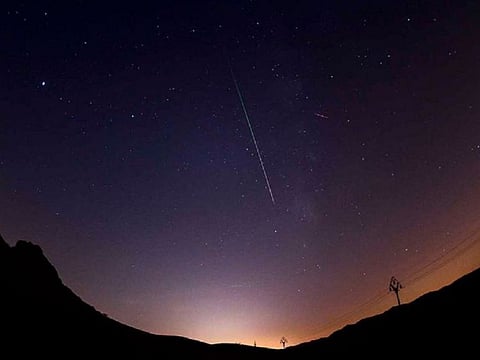Enjoy free skywatching event in UAE: Get ready for Perseid meteor showers peak
Celestrial event provides exceptional chance for stargazers

Sharjah: Stargazers are set to gather around Sharjah’s Mleiha Archaeological Centre as the August Perseid meteor shower, a captivating celestial event, is set to peak in 2023.
The much-anticipated and renowned ‘Perseids’ is one of the most popular meteor events of the year. To mark this celestial spectacle, a special skywatching event has been meticulously organised at Mleiha, coinciding with the meteor shower’s peak.
The place is a popular site for stargazers. The emirate’s leading archaeological and eco-tourism project, developed by the Sharjah Investment and Development Authority (Shurooq), is located in the historic dunes of Mleiha, approximately 40 minutes away from Sharjah city lights.
Free show above
The Perseids, famous for their striking fireballs, magnificent explosions of vivid light and colour that linger in the night sky, grace us annually.
This year, the peak is anticipated on the night of August 12-13, as the conditions will be nearly perfect to observe this annual phenomenon.
Consistent meteor showers
Families enjoying their August vacations in dark, rural locations often stumble upon these shooting stars, and late-summer campers delight in witnessing this reliable and awe-inspiring shower.
The Perseids, alongside the Geminids in December, rank among the most robust and consistent meteor showers each year.
Earth’s orbit leads us through the densest part of the Perseid meteoroid stream around August 12, granting us a predictable display of these meteoric wonders.
Hourly rates
The hourly rates of Perseids can vary, but under a clear, dark sky, keen observers can typically spot over 60 meteors per hour between midnight and dawn.
According to the “2023 Observer’s Handbook” by the Royal Astronomical Society of Canada, Earth is expected to pass through the densest part of the Perseid stream around 4 am EDT (around 12 noon in the UAE) on Sunday, August 13.
This momentary peak, lasting around eight or nine hours, offers an exceptional viewing opportunity, in the Middle East particularly in desert areas away from city lights.
Consequently, the late-night hours of August 12 to the early morning of August 13 present a prime window for witnessing a spectacular Perseid display.
Fortunately, the moon’s illumination will not hinder the viewing experience this year as it did during the previous year’s shower.
In 2023, the moon will be a lovely waning crescent, only 8-percent illuminated, and it will not rise until approximately 3 a.m. local daylight time on August 13. This favorable lunar phase makes 2023 an opportune year to witness the August Perseids in all their glory.
Origin of Perseid shower
The Perseid shower originates from comet 109P/Swift-Tuttle, which follows a lengthy elliptical orbit around the sun. As the comet nears the sun, it sheds fragments of its material, leaving behind a sparse “river of rubble” in space. These meteoroids, ranging from tiny sand grains to pebbles, collide with Earth’s atmosphere at an astonishing speed of 40 miles (60 km) per second, creating luminous trails as they vaporize.
On the peak night, the Perseids will appear to radiate from a region between the Perseus and Cassiopeia constellations, close to the renowned Perseus Double Cluster.
Sign up for the Daily Briefing
Get the latest news and updates straight to your inbox

